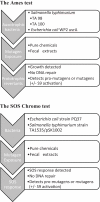Recent Perspectives on the Relations between Fecal Mutagenicity, Genotoxicity, and Diet
- PMID: 21779247
- PMCID: PMC3132665
- DOI: 10.3389/fphar.2011.00004
Recent Perspectives on the Relations between Fecal Mutagenicity, Genotoxicity, and Diet
Abstract
DNA damage is an essential component of the genesis of colonic cancer. Gut microbial products and food components are thought to be principally responsible for the damage that initiates disease progression. Modified Ames tests and Comet assays have been developed for measuring mutagenicity and genotoxicity. Their relevance to oncogenesis remains to be confirmed, as does the relative importance of different mutagenic and genotoxic compounds present in fecal water and the bacteria involved in their metabolism. Dietary intervention studies provide clues to the likely risks of oncogenesis. High-protein diets lead to increases in N-nitroso compounds in fecal water and greater DNA damage as measured by the Comet assay, for example. Other dietary interventions, such as non-digestible carbohydrates and probiotics, may lead to lower fecal genotoxicity. In order to make recommendations to the general public, we must develop a better understanding of how genotoxic compounds are formed in the colon, how accurate the Ames and Comet assays are, and how diet affects genotoxicity.
Keywords: Ames test; DNA; N-nitroso compounds; colon; comet assay; diet; feces; human.
Figures
Similar articles
-
Variability in fecal water genotoxicity, determined using the Comet assay, is independent of endogenous N-nitroso compound formation attributed to red meat consumption.Environ Mol Mutagen. 2006 Apr;47(3):179-84. doi: 10.1002/em.20181. Environ Mol Mutagen. 2006. PMID: 16304669
-
The comet assay with multiple mouse organs: comparison of comet assay results and carcinogenicity with 208 chemicals selected from the IARC monographs and U.S. NTP Carcinogenicity Database.Crit Rev Toxicol. 2000 Nov;30(6):629-799. doi: 10.1080/10408440008951123. Crit Rev Toxicol. 2000. PMID: 11145306 Review.
-
Fecal water genotoxicity is predictive of tumor-preventive activities by inulin-like oligofructoses, probiotics (Lactobacillus rhamnosus and Bifidobacterium lactis), and their synbiotic combination.Nutr Cancer. 2004;49(2):144-55. doi: 10.1207/s15327914nc4902_5. Nutr Cancer. 2004. PMID: 15489207
-
Fecal water genotoxicity in healthy free-living young Italian people.Food Chem Toxicol. 2014 Feb;64:104-9. doi: 10.1016/j.fct.2013.11.019. Epub 2013 Dec 1. Food Chem Toxicol. 2014. PMID: 24296136
-
The comet assay for the evaluation of gut content genotoxicity: Use in human studies as an early biomarker of colon cancer risk.Mutat Res Genet Toxicol Environ Mutagen. 2022 Jun;878:503477. doi: 10.1016/j.mrgentox.2022.503477. Epub 2022 Feb 24. Mutat Res Genet Toxicol Environ Mutagen. 2022. PMID: 35649683 Review.
Cited by
-
Raw and Sous-Vide-Cooked Red Cardoon Stalks (Cynara cardunculus L. var. altilis DC): (Poly)phenol Bioaccessibility, Anti-inflammatory Activity in the Gastrointestinal Tract, and Prebiotic Activity.J Agric Food Chem. 2021 Aug 18;69(32):9270-9286. doi: 10.1021/acs.jafc.1c03014. Epub 2021 Aug 4. J Agric Food Chem. 2021. PMID: 34347467 Free PMC article.
-
Probiotic antigenotoxic activity as a DNA bioprotective tool: a minireview with focus on endocrine disruptors.FEMS Microbiol Lett. 2020 Feb 1;367(3):fnaa041. doi: 10.1093/femsle/fnaa041. FEMS Microbiol Lett. 2020. PMID: 32124914 Free PMC article. Review.
-
Bacterial Composition, Genotoxicity, and Cytotoxicity of Fecal Samples from Individuals Consuming Omnivorous or Vegetarian Diets.Front Microbiol. 2017 Feb 28;8:300. doi: 10.3389/fmicb.2017.00300. eCollection 2017. Front Microbiol. 2017. PMID: 28293225 Free PMC article.
-
Effect of vitamins C and E on cancer survival; a systematic review.Daru. 2022 Dec;30(2):427-441. doi: 10.1007/s40199-022-00451-x. Epub 2022 Sep 22. Daru. 2022. PMID: 36136247 Free PMC article.
-
Towards microbial fermentation metabolites as markers for health benefits of prebiotics.Nutr Res Rev. 2015 Jun;28(1):42-66. doi: 10.1017/S0954422415000037. Nutr Res Rev. 2015. PMID: 26156216 Free PMC article. Review.
References
-
- Ames B. N., McCann J., Yamasaki E. (1975). Methods for detecting carcinogens and mutagens with the Salmonella/mammalian-microsome mutagenicity test. Mutat. Res. 31, 347–364 - PubMed
-
- Benassi-Evans B., Clifton P., Noakes M., Fenech M. (2010). High-protein/high red meat and high-carbohydrate weight-loss diets do not differ in their effect on faecal water genotoxicity tested by use of the WIL2-NS cell line and with other biomarkers of bowel health. Mutat. Res. 703, 130–136 - PubMed
-
- Bingham S. A., Hughes R., Cross A. J. (2002). Effect of white versus red meat on endogenous N-nitrosation in the human colon and further evidence of a dose response. J. Nutr. 132, 3522S–3525S - PubMed
LinkOut - more resources
Full Text Sources



